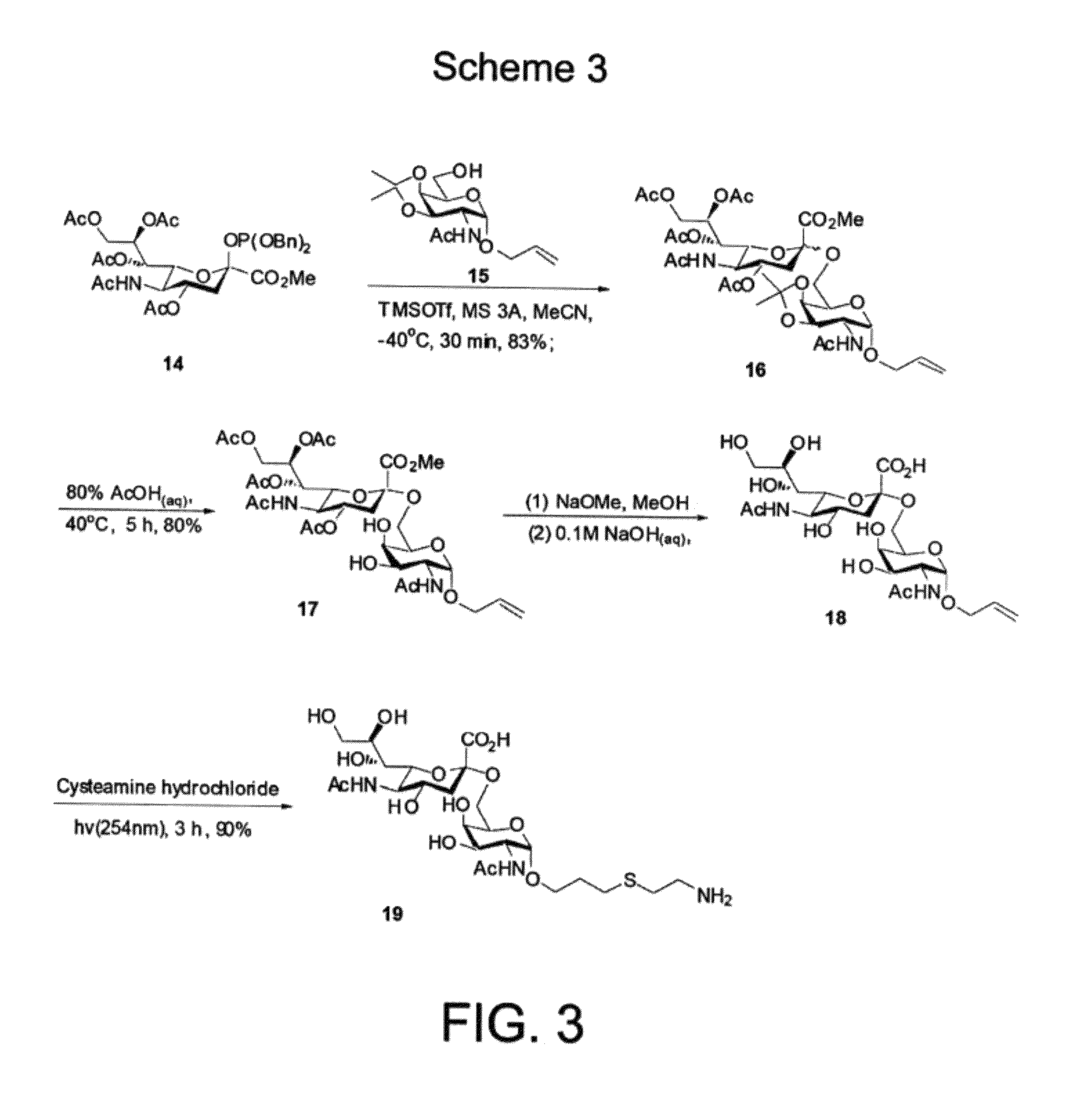Immunogenic protein carrier containing an antigen presenting cell binding domain and a cysteine-rich domain
a technology of antigen presenting cell and immunogenic protein, which is applied in the field of immunogenic protein carrier containing an antigen presenting cell binding domain and a cysteine-rich domain, can solve the problems of low conjugation efficiency between klh/bsa and a sugar epitope, and achieve the effect of improving its antigenecity
- Summary
- Abstract
- Description
- Claims
- Application Information
AI Technical Summary
Benefits of technology
Problems solved by technology
Method used
Image
Examples
example 1
Immunogenic Protein Carrier Preparation
[0029]A DNA fragment encoding seven tandem repeats of the cysteine-rich peptide Pro-Cys-Cys-Gly-Cys-Cys-Gly-Cys-Gly-Cys (SEQ ID NO: 1) was prepared by template-repeat PCR technology as described in Hsu et al., Cancer Research 60:3701-3705, 2000. The DNA fragment was further modified to create Bam HI and Hind III restriction sites at the 5′ and 3′ ends of the DNA fragment, respectively. It was then cloned into expression vectors containing a fragment encoding a His-tag and either a fragment encoding the Fc domain of rabbit IgG or a fragment encoding the Fc domain of mouse IgG. The resultant expression plasmids were capable of expressing fusion proteins including, from the N-terminus to the C-terminus, the rabbit or mouse Fc domain, the seven repeats of the cysteine-rich peptide, and two copies of a His-tag (“rFc-Cys-rich7-H2 protein carrier” and “mFc-Cys-rich7-H2 protein carrier”).
[0030]The expression plasmids mentioned above were introduced int...
example 2
Immunoconjugate Preparation
[0031]Antigen sTn was synthesized following the synthetic route illustrated in FIG. 3. Briefly, the phosphite N-acetylneuraminic acid 14, prepared from neuraminic acid, was deprotected and coupled with the acetonide 15 to afford a 3:2 (α:β) mixture of the 1,6-linked sialoside 16 in 83% yield under the conventional conditions. The α / β anomers were separated after acidic deprotection of the corresponding acetonides. One of the anomers (17) was then further deprotected using NaOMe in MeOH and 0.1 M NaOH solution at room temperature to afford compound 18 (quant.). In order to attach the sTn to carrier proteins, the amine group was introduced onto the alkenyl moiety of 18 using photochemical activation with Cysteamine hydrochloride to provide 19 (90%), which was purified by a Biogel P2 column.
[0032]Antigen sTn, prepared by the method described above, conjugated with a linker containing a maleimide functional group (see FIG. 2, panel B), were mixed with the mFc-...
example 3
Use of Immunoconjugate for Eliciting Antibody Production
Mice Immunization
[0034]Male Balb / c mice (8 weeks old) were injected subcutaneously with the mFc-Cys-rich7-sTn immunoconjugate (containing 20 μg sTn), once every two weeks for three times. Sera were collected from the immunized mice each week and analyzed by dot blotting to examine presence of anti-sTn antibodies.
[0035]Male Balb / c mice (6-8 weeks old) were injected subcutaneously with an immunoconjugate containing the mFc-Cys-rich7-H2 carrier conjugated with GM3. The immunoconjugate was first suspended in complete Freund's adjuvant, which was switched to incomplete Freund's adjuvant two weeks later. Sera were collected from the immunized mice each week and subjected to dot blotting for examining presence of anti-GM3 antibodies.
Determination of Antibody Titers
[0036]Each serum sample obtained from the mice immunized with the mFc-Cys-rich7-sTn immunoconjugate, diluted by 1000 fold with a TBS buffer (25 mM Tris-HCl pH8.0, 125 mM NaC...
PUM
| Property | Measurement | Unit |
|---|---|---|
| pH | aaaaa | aaaaa |
| immune composition | aaaaa | aaaaa |
| structures | aaaaa | aaaaa |
Abstract
Description
Claims
Application Information
 Login to View More
Login to View More - R&D
- Intellectual Property
- Life Sciences
- Materials
- Tech Scout
- Unparalleled Data Quality
- Higher Quality Content
- 60% Fewer Hallucinations
Browse by: Latest US Patents, China's latest patents, Technical Efficacy Thesaurus, Application Domain, Technology Topic, Popular Technical Reports.
© 2025 PatSnap. All rights reserved.Legal|Privacy policy|Modern Slavery Act Transparency Statement|Sitemap|About US| Contact US: help@patsnap.com



